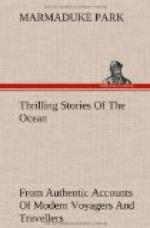I hope he reached the Hot-Wells in safety after all, and sold his poultry for as much as he expected; and, what is still better, that his heart was filled with gratitude to God for his preservation from danger so imminent.
[Illustration: The life boat.]
THE LIFE BOAT.
Oh what a stirring scene is this! see how the brave fellows are pulling with their oars, and endeavoring with all their might to reach the ship in distress before it is too late! Well, I suppose you are curious to know how an open boat like this can float in such an angry, boiling sea. I will tell you how it is accomplished; the sides of the boat are lined with hollow boxes of copper, which being perfectly air-tight, render her buoyant, even when full of water, or loaded to the very water’s edge.
The originator of this simple and beautiful contrivance was a London coach maker, named Lionel Lukin, a man whose benevolent feelings flowed towards all his fellow men, but more especially towards that portion of them who brave the dangers of the sea. After devoting sixty years of his life to the pursuits of his business, he retired to Hythe in Kent, where he finished a well-spent life in peace and tranquility, dying in February, 1834. His body was interred in the churchyard of Hythe, which is situated on rising ground, commanding a fine view of the ocean; a fit resting place for the remains of one whose talents had been successfully directed to the means of rescuing from shipwreck and a watery grave many hundreds, or perhaps we may say many thousands, of poor seamen. He obtained a patent for his first boat in 1785.
The two sailors in the picture below are Greenwich pensioners, supported, you know, at Greenwich Hospital, which was founded by Charles II. for superannuated or wounded sailors. They are smoking their pipes, and discussing the merits of the Life Boat.
[Illustration: The whale.]
WHALE FISHING.
The whale is the largest of all known animals. There are three kinds of whale; the Greenland, called by the sailors the right whale, as being most highly prized by them; the great northern rorqual, called by fishers the razor-back or finner, and the cachalot or spermaciti whale. The common whale measures from sixty to seventy feet in length: the mouth, when open, is large enough to admit a ship’s jolly boat, with all her men in it. It contains no teeth; and enormous as the creature is, the opening to the throat is very narrow, not more than an inch and a half across in the largest whale.
[Illustration: Whale fishing]
Instead of teeth the mouth of the whale is furnished with a curious framework of a substance called baleen; you will know it by the name of whalebone; it is arranged in rows, and projects beyond the lips in a hanging fringe; the food of the whale consists of shrimps, small fishes, sea-snails, and innumerable minute creatures, called medusae, which are found in those seas where the whales feed in such vast quantities that they make the water of a deep green or olive color.




